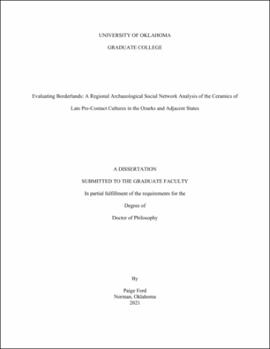| dc.contributor.advisor | Livingood, Patrick | |
| dc.contributor.author | Ford, Paige A. | |
| dc.date.accessioned | 2021-08-05T18:45:27Z | |
| dc.date.available | 2021-08-05T18:45:27Z | |
| dc.date.issued | 2021-08-05 | |
| dc.identifier.uri | https://hdl.handle.net/11244/330222 | |
| dc.description.abstract | This dissertation investigates regional interactions within and surrounding the Ozark Plateau during the Late Pre-Contact period. In doing so, I evaluate extant assumptions that the Neosho culture (AD 1400-1650) exhibited the characteristics of a borderland community (i.e., location between major political and social formations, low population density, and increased social diversity). Neosho communities were ascribed the roles of a borderland society simply because of their geographic residence between two major environmental regions—the Eastern Woodlands and the Great Plains—and researchers have relied upon these and related categorical assumptions in interpreting Neosho regional interactions. The framework used here incorporates theories on borderland dynamics, communities of practice, and social network analysis to illustrate interpretations hinging upon taxonomic categorizations and corresponding assumptions fall short in modeling the relational dynamics of past communities.
This study has several components designed to address enduring questions about and update our current knowledge about Neosho communities as well as to investigate relationships in this region. The bulk of this dissertation focuses on the examination of approximately 6,500 ceramic sherds from 23 sites in the region to investigate networks of interaction and practice in two dimensions: restrictive learning communities of practice and broad social affiliations. Second, this study summarizes subsistence data to investigate how Neosho’s practices compare to surrounding groups, consequently disregarding classificatory perspectivs seeking to categorize Neosho “Plains-like” or “Eastern Woodlands-like” in their practices and affiliations. Lastly, new AMS dates provide an updated understanding of the overall history of this area and confirm that the sites chosen for analysis were contemporaneous.
Contrary to previous research on Neosho communities, this study shows that the relationships built and maintained by peoples in this region do not indicate Neosho is a borderland group. Instead, Neosho peoples built relationships such that they were a distinct and strongly interconnected social community, while maintaining several strong relationships with several surrounding groups. As such, this research shows the importance of evaluating our existing categories like typologies and culture areas, in that they sometimes mask important patterns concerning the relationships of past communities. This research also illustrates borderlands and boundaries through time are multidimensional and shifting, emphasizing that it is essential for archaeologists to utilize relational techniques and approaches such as these to investigate and evaluate our predetermined categories and associated assumptions. | en_US |
| dc.language | en_US | en_US |
| dc.subject | Archaeology | en_US |
| dc.subject | Social Network Analysis | en_US |
| dc.subject | Ceramics | en_US |
| dc.subject | Borderlands | en_US |
| dc.title | Evaluating Borderlands: A Regional Archaeological Social Network Analysis of the Ceramics of Late Pre-Contact Cultures in the Ozarks and Adjacent States | en_US |
| dc.contributor.committeeMember | Hammerstedt, Scott | |
| dc.contributor.committeeMember | Regnier, Amanda | |
| dc.contributor.committeeMember | Trabert, Sarah | |
| dc.contributor.committeeMember | Pailes, Matthew | |
| dc.contributor.committeeMember | Cline, Rangar | |
| dc.contributor.committeeMember | Marshall, Kimberly | |
| dc.date.manuscript | 2021-07-29 | |
| dc.thesis.degree | Ph.D. | en_US |
| ou.group | College of Arts and Sciences::Department of Anthropology | en_US |
| shareok.nativefileaccess | restricted | en_US |
